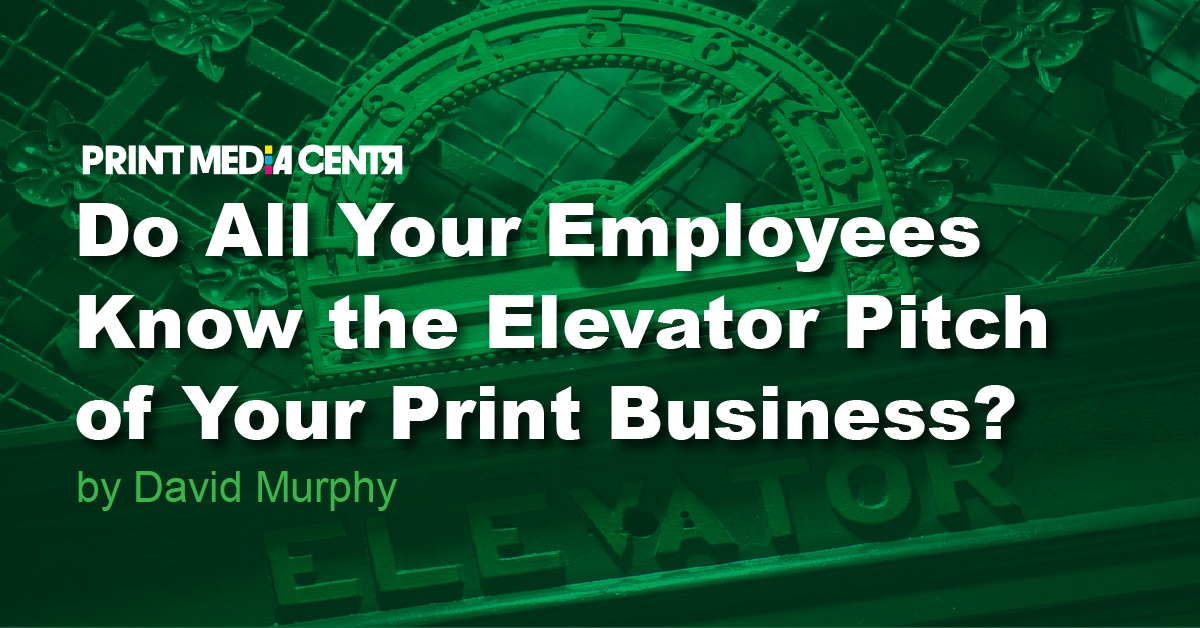
No. The answer is no, they don’t. Some of your employees are non-customer-facing so MAYBE it’s not necessary for them to learn your company’s pitch. Or MAYBE it is.
What about your customer-facing employees? Your sales, customer service, and marketing staff? Do they all deliver roughly the same pitch or do they all tell the story a different way?
First, an important refresher on the purpose and structure of the elevator pitch. Sure, we all know the basic definition: a short intro statement you give a stranger, which takes the same amount of time to present as an elevator ride. Got it.
If it were that basic and unrefined, then some of your employees may be saying something like, “We are XYZ Print. We’ve been providing print in XYZ-ville for XX years. We can print anything you need.”
This example isn’t terrible. It’s concise, if not compelling. The alternative to this pitch could be something much longer, much more ambiguous, and much less likely to get a prospect to say, “Tell me more!”
So let’s agree on what an elevator pitch is and what it should sound like:
An Elevator Pitch is a concise verbal statement that clearly articulates how your company helps your targeted customers solve problems.
The statement must be:
- Clear – (Very easy to say and to understand.)
- Concise – (Fewer than 70 words, which can be delivered in 30 seconds or less.)
- Compelling – (Inspiring, interesting, intriguing.)
- Customer-benefit focused – (How do you help customers?)
In my experience, it’s best to write the pitch, try it out loud, edit it, rewrite it, and try it again until you get it right. Then practice it and learn it. It may not come out the same every single time because we aren’t robots. But it should sound roughly similar and hit the key points most every time.
To help with this writing process, try applying your company attributes to this template:
- At [OUR COMPANY], we provide [PRODUCT] for [TARGET CUSTOMERS] that allows them to [OUR VALUE PROPOSITION].
- We have [EXPERIENCE], and unlike [COMPETITOR], we [DIFFERENCES].
- End with a Call To Action or QUESTION.
Here is one crack at it from a sustainability-focused direct mail printer:
- At XYZ Printing, we provide sustainable print and direct marketing solutions to the XYZ market, allowing our customers to promote their brands and attract new clients with efficient, targeted communications.
- Our environmentally responsible practices reduce our ecological footprint. Unlike our competitors, we meet the rigorous standards of Sustainable Green Partnership certification.
- What kinds of eco-friendly print materials does your company use?
In my opinion, this is clear, concise, compelling, and customer-benefit focused. It is 61 words and can be verbally delivered in under 30 seconds. If you don’t like this wording, change it, but try to meet the 4C criteria using your own style.
If all your customer-facing employees go through this exercise and use roughly the same pitch, you should start to see some consistency in how they present your company’s value proposition to strangers and how they engage them in a new discussion. I recommend making this a group exercise in a staff training meeting. Over time, they should learn from one another about how to improve on it for better results.
What about those non-customer-facing employees? Should they learn it as well?
In my opinion, yes. Each of them engages with friends, family, and strangers during their non-working hours. These employees might be asked, “Where do you work, what do you do, how do you like it?” If they can present a clear, compelling statement similar to the one above, they might be able to bring in a new business lead on their own. Why not?
If your team members’ pitch doesn’t isn’t sound something like the example above, what are they saying to potential customers?
 David Murphy is the founder and CEO of Nvent Marketing, a marketing agency specializing in digital marketing for the print industry. David has 30+ years of experience in the graphics and document print production industry. He has served as a board member and advisor to print organizations and associations including Sustainable Green Printing Partnership (SGP), Print Industries of America (PIA), Association for Print Technologies (APTECH), and Electronic Document Scholarship Foundation (EDSF). David was also awarded the Idealliance Soderstrom Society Award for Print Industry Leadership.
David Murphy is the founder and CEO of Nvent Marketing, a marketing agency specializing in digital marketing for the print industry. David has 30+ years of experience in the graphics and document print production industry. He has served as a board member and advisor to print organizations and associations including Sustainable Green Printing Partnership (SGP), Print Industries of America (PIA), Association for Print Technologies (APTECH), and Electronic Document Scholarship Foundation (EDSF). David was also awarded the Idealliance Soderstrom Society Award for Print Industry Leadership.
David can be reached at [email protected].











